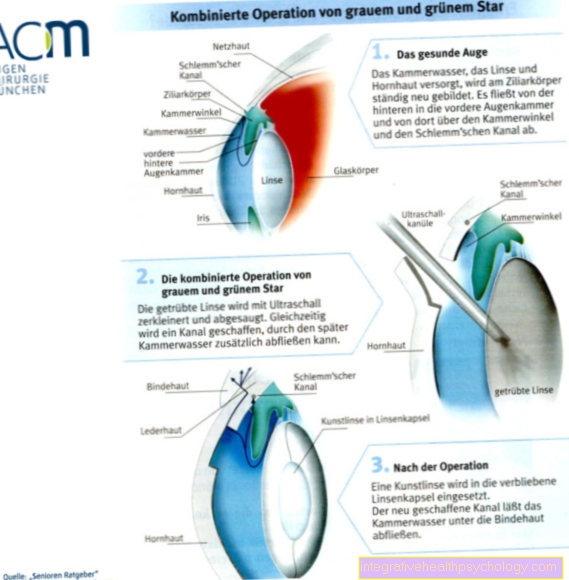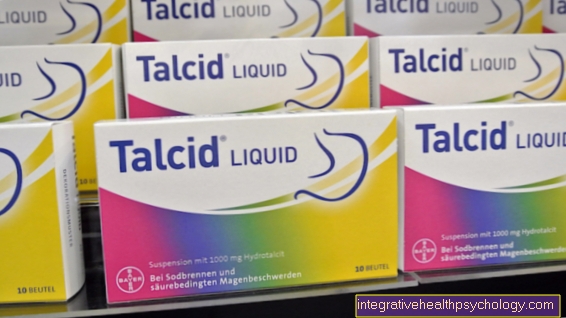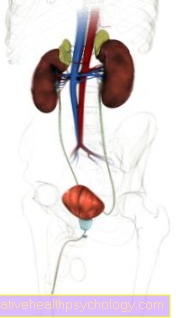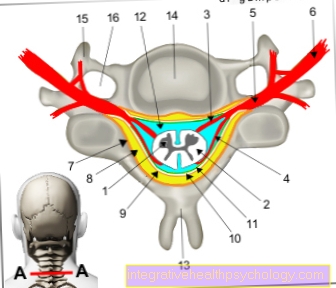Life expectancy in COPD
definition
The abbreviation COPD stands for "chronic obstructive pulmonary disease", which means "chronic obstructive pulmonary disease" in German. Chronic means that the disease will last a long time. Obstructive means that COPD is accompanied by a narrowing of the bronchi, which accounts for a large part of the symptoms, e.g. Shortness of breath. COPD cannot be treated in terms of its cause, but only symptomatically. Over time, the disease gets worse and symptoms increase. Life expectancy is limited by this chronic disease, its symptoms and complications.
Read more on the subject at: COPD

Which factors have a positive influence on life expectancy in COPD?
Stop smoking
Smoking is a common cause of COPD. If the patient does not use cigarettes after the diagnosis has been made, the progression of the disease is slowed down and the symptoms are less pronounced. Life expectancy is also positively influenced by quitting smoking; studies have shown a life extension in comparison to patients who did not give up tobacco consumption.
Oxygen therapy
In the later stages of COPD, breathing may gradually worsen, which medical professionals call respiratory failure. Long-term therapy with oxygen, which is available to the patient around the clock, has been shown to improve life expectancy.
Elimination of occupational noxae
Workers in mining, industry and road traffic can be exposed to increased pollution from fine dust. If such a burden is present in a patient with COPD, the relevant work environment should only be visited with appropriate protective measures or not at all.
Vaccinations
Deaths from COPD are often related to an acute infection of the bronchi and / or lungs. The one-time vaccination against pneumococci and the annual vaccination against influenza (flu) help to prevent these infectious diseases and prevent a possible bad outcome.
Regular drug therapy
COPD also needs treatment when symptoms are mild or nonexistent. Regular therapy can reduce the frequency and severity of serious infections. An adapted therapy can extend the survival of a patient with COPD.
Patient-related factors
Younger patients without other severe comorbidities have a longer life expectancy than older patients with severe comorbidities, e.g. Heart failure, heart attack, diabetes, high blood pressure.
Which factors negatively affect life expectancy in COPD?
Smoke
Smoking is a common cause of COPD. If the patient does not give up cigarettes after the diagnosis has been made, the progression of the disease will accelerate. This has a negative impact on life expectancy; studies have shown that life is shorter than that of patients who gave up tobacco consumption.
Frequent exacerbations
An exacerbation is a worsening of COPD that goes beyond the normal range of fluctuations between individual days and lasts for more than a day. Symptoms are increasing shortness of breath and coughing with increased sputum (possibly greenish-yellowish discoloration). The cause is often an infection of the bronchi and / or lungs. If these exacerbations occur frequently, the course of COPD is negatively affected and life expectancy is shortened.
Read more on the subject at: Symptoms of COPD
High age
Due to the higher likelihood of comorbidities and a reduced ability of the body to compensate for illnesses and functional restrictions, old age is also associated with a poorer life expectancy in COPD.
Hypercapnia
As the duration of the illness increases, COPD leads to a deterioration in the lungs and respiratory function. Due to the poor breathing, the lungs are unable to breathe out sufficient amounts of carbon dioxide, which increases the carbon dioxide level in the blood, which is known as hypercapnia. This can lead to a feeling of breathlessness. Because hypercapnia in COPD develops slowly, the body gets used to the high carbon dioxide levels in the blood. A strong increase in this level has a toxic effect and also leads to acidification of the blood, which in turn has far-reaching consequences on the metabolism. Hypercapnia therefore always carries the risk of acute deterioration and has a negative impact on life expectancy.
Oral steroids
If a patient is treated with oral steroids ("cortisone") for another condition before he or she is diagnosed with COPD, life expectancy will decrease. The reason for this is that taking cortisone preparations is an integral part of therapy for COPD from stage 3. A pre-existing therapy therefore worsens the treatment options and thus the course of the disease.
Patient-related factors
Older COPD patients with severe comorbidities such as heart failure, heart attack, diabetes, and high blood pressure have a poorer life expectancy than (younger) patients without other severe comorbidities.
What is the life expectancy in stage 1?
In stage 1, patients are only slightly restricted by COPD. Chronic symptoms may be absent, but typical are cough, phlegm and shortness of breath during intense physical activity. The lung function test is normal, many patients are not yet aware of their lung disease. On average, the life expectancy of a patient with COPD drops by 5-7 years compared to the normal healthy population without COPD. However, it is always difficult to make precise predictions about life expectancy, as many individual factors play an important role. In stage 1, the FEV1 values (forced expiratory volume, one-second capacity) reach almost normal values, which are between 1.5-4 liters, depending on sex and age. Life expectancy is only slightly restricted in stage 1.
Read more about the topic at: COPD stages
What is the life expectancy in stage 2?
In stage 2, patients are moderately restricted by COPD. Chronic symptoms may also be absent here, but occur more frequently. The lung function is slightly restricted and lies between 50 and 80 percent of the normal value. The one-second capacity of the lungs continues to decrease, in non-smoking COPD patients by approx. 30 ml per year, in smokers with COPD even by up to 90 ml per year. At this stage, stopping smoking, avoiding pollutants in the air, a healthy lifestyle, regular breathing training / respiratory gymnastics and consistent drug therapy can have a significantly positive effect on life expectancy.
What is the life expectancy in stage 3
In stage 3, patients are severely restricted by COPD, and the chronic symptoms increase in frequency and severity. The lung function is clearly restricted and lies between 30 and 50 percent of the normal value. If the one-second capacity is between 750ml and 1250ml, the average life expectancy is around 5 years. However, it is always difficult to make precise predictions about life expectancy, as many individual factors play an important role. Even at this stage, stopping smoking, avoiding pollutants in the air, a healthy lifestyle, regular breathing training / breathing gymnastics and consistent drug therapy can have a positive effect on life expectancy. Life expectancy is also positively influenced by 24-hour oxygen therapy if the breathing capacity of the lungs continues to decrease and oxygen therapy is started early enough.
What is the life expectancy in stage 4
In stage 4, the end stage, the patients are severely restricted by COPD, the body is always poorly supplied with oxygen due to the symptoms of the disease. The lung function is very clearly restricted and is below 30 percent of the normal value. In this late stage, secondary diseases often occur due to the permanent stress on the other organs, e.g. a heart failure. These also reduce life expectancy. If the one-second capacity is less than 750ml, the average life expectancy is around 3 years. A third of patients die within a year of being diagnosed with stage 4 COPD. However, it is always difficult to make precise predictions about life expectancy, as many individual factors play an important role.
Read more on the subject at: End-stage COPD


.jpg)


























